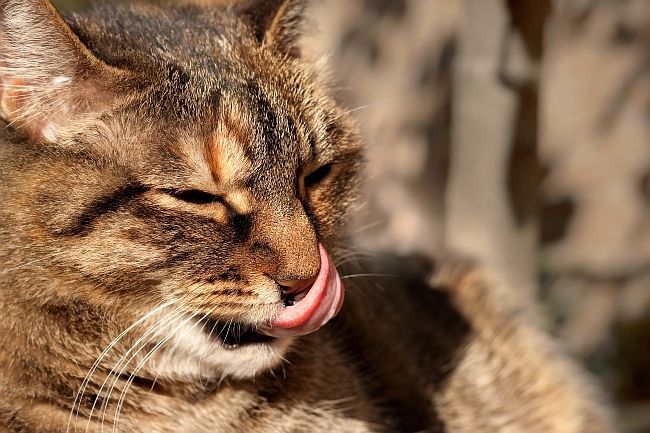
Why does it feel like sandpaper when your cat licks you? Is the kitty in need of a drink because his tongue is just horribly dry? Unlike dogs and humans, a feline tongue has a rough feeling because it is covered in little fissures call papillae. The papillae is constructed like tiny backward barbs made of the same hard substance as our fingernails, called keratin. This was designed to help your cat clean her coat. The little fissures and barbs are like mini combs, sorting through and brushing cat’s fur. Grooming this way helps the feline remove dust, dirt, and loose hair so she can stay sleek and clean.
Why cats groom
Historically, the papillae was necessary for cats to feed themselves in the wild, as the keratin helps breakdown and remove flesh from prey. Cats also groom to survive in the wilderness, since they do not want to leave any evidence or traces of where they have been, and grooming removes the smell.
Cats tend to over groom when they are stressed out, and need to be calmed. The act of grooming actually releases endorphins in the cat, and in times of great stress can actually result in psychogenic alopecia, or bald spots and sores as a result from too much grooming. If you start to notice increasing hot spot areas and baldness, see a vet and talk to her about how to lower your cat’s stress levels.
How the tongue works
A feline’s tongue is unusual in other ways, in that they have far fewer taste buds than humans, and have no palate for sweet treats. As carnivores, cats were intended to only eat meat, and therefore have no need to consume anything that might have a sweet/sugary flavor. This is probably for the better, since one of the most common cat ailments is dental disease, and sugar is a fast-track to tooth decay.
A cat’s tongue is the miraculous tool that they rely upon for drinking water. Once believed to act as a spoon and curl around the liquid before quickly pulling up pockets of water, the cat’s tongue functions in a completely different way. The tongue dips downward and then flicks across the surface of the water, causing a small tube of water to be pulled off the surface. The cat’s mouth closes over this water column before it has time fall back into the bowl. The cat’s tongue moves this way at the rate of 4 times per second – too fast for detection by the human eye. Thank goodness for the guys at Massachusetts Institute of Technology, Virginia Polytechnic Institute, and Princeton who filmed the process in slow motion, and solved the mystery of how cat’s drink water!

